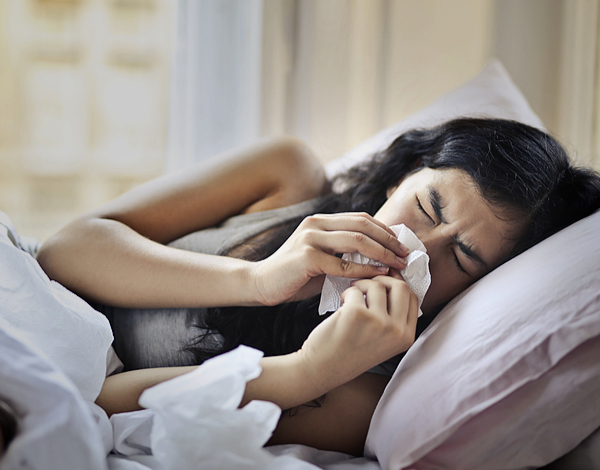
Photo: Daniel Odame/Unsplash
 by Matt SheehanOSF Healthcare
by Matt SheehanOSF Healthcare
PEORIA - There’s a new hope for people facing amputations, and it’s in a mix of fascinating, perhaps unexpected methods.
Roughly 465,000 amputations take place in the United States each year, with 83% of them being lower limb amputations like toes and legs, according to the Amputee Coalition.
Eric Martin, DO, the chief of Vascular Surgery at OSF HealthCare Saint Francis Medical Center in Peoria, Illinois, has crafted a predictable and consistent method that provides reliable outcomes for heroic limb salvage. He does it through procedures referred to as regenerative reconstruction, a treatment currently reserved for the most serious of cases like severe bacterial infection, traumatic crushed limbs, and lower limb ulcers that have become infected and spread throughout the body. These procedures normally accompany a lower limb revascularization with either a bypass procedure or angioplasty and stenting.
“We're here to treat people who have a lot of disadvantaged anatomy and protoplasm (living part of cells) with many medical comorbidities, who otherwise would not be able to heal. Through
regenerative reconstruction, we're able to accelerate wound healing and accelerate healing of other diseases processes much quicker,” Dr. Martin says. “In the past, amputation or death was the end point. Now we're able to save lives, have a much more robust limb salvage program here at OSF HealthCare which also makes a difference in terms of affecting mortality in certain patients."
OSF Saint Francis is the only location in Illinois performing advanced regenerative reconstruction procedures at this high of a level.
"We like to pride ourselves on being at the tip of the spear at regenerative reconstruction in the state of Illinois," Dr. Martin says. “We've built that up by having good relationships with companies and getting our hands on the latest and greatest products on the market. We’re always trying to optimize our arsenal of regenerative medicine to provide the best results for our patients. Not only to help with the regenerative reconstruction phase, but also to help address chronic biofilm (bacteria) in the inflammatory phase of wound healing.”
Fish skin, pig intestine, pig bladder and more!
Dr. Martin’s algorithm is built by a group of surprising products made up of animal tissue (xenografts) and human tissue (allografts). This includes fish skin, pig intestine, pig bladder, cow tendon and tissue from human umbilical cords that come from planned procedures with women who have planned, elective C-sections.

Photo provided
Dr. Eric Martin
"The healing capabilities of the fish skin have been quite remarkable," Dr. Martin says. “One of the big reasons is that it's very homologous (same make up) to human skin. The characteristics and composition of the fish skin are nearly identical to what you'd see with human skin. If you'd take a slice of human skin and a slice of fish skin and put it under an electron microscope and look at it, it'd almost look identical.”
The fish skin manufactured by Kerecis, a company in Iceland, spurs on new blood vessel growth and collagen deposition, and eventually helps encourage growth of the outer layer of skin. The fish are caught from the northern Atlantic Ocean near Iceland, and are then skinned and manufactured in plants located in Ísafjörður, Iceland. Dr. Martin started using the fish skin products in August 2023.
Smith calls regenerative reconstruction “medical miracles
Joe Smith, executive vice president of Research and Development and Product Life Cycle at Kerecis, traveled with other researchers to Peoria to learn more about Dr. Martin’s case studies. He says through these techniques, the world is going to see patients healed in ways we never have before.
“We harvest the fish skin right out of the ocean, take the scales off, and put it through a very gentle process,” Smith says. “What comes out is a medical device, homologous to human tissue, and totally absorbs in the body in seven days.”
Smith calls regenerative reconstruction “medical miracles,” and says with the combination of talented surgeons and top tier products these life-saving procedures can be done more and more.
"We also use pig bladder and pig intestine. One company (Organogenesis) has been able to take pig intestine and cross link it to increase its structural integrity and combine it with type 1 collagen. They then add PHMB (Polyhexamethylene biguanide) which is a very powerful antimicrobial agent. When this tissue is put into the human body, it's very good at killing
recalcitrant bacteria that are resistant to antibiotics taken by mouth or through the veins," Dr. Martin says.
When Dr. Martin’s patients arrive at the hospital, their wound’s cross-sectional area can cover an entire lower leg or foot, depending on where the infection is. But the wounds don’t start that way. Even a quarter size ulcer on the bottom of someone’s foot, if left untreated, can grow substantially.
Pyoderma gangrenosum cure
A recent case is the first of its kind in the world of medicine. Dr. Martin and his team were able to cure a patient with a rare autoimmune disease called pyoderma gangrenosum. Traditionally, this disease did not have a cure and was treated with corticosteroids and immunosuppressive agents only. These medications had many unwanted side effects for patients.
“This is the first surgical cure in the history of medicine, where we were able to eradicate the ulcers that formed in his leg and were present for over a decade through the use of surgery and regenerative medicine," Dr. Martin says. "It was really the regenerative medicine that helped provide immunomodulation and benefit to him to help suppress his body's own immune system and allow him to heal and recover so nicely.”
Many people get amputations because after undergoing treatment time and time again, their wounds just won’t heal
Who could benefit from this treatment?
Dr. Martin says in the past, medication was offered to patients, but oftentimes the medicine would have side effects with it.
“So now by avoiding long-term use of medicine with many deleterious side effects, the surgery was curative for this patient, and he's done very, very well,” Dr. Martin says.
Most of his patients have diabetes and a history of compromised circulation or have peripheral artery disease. Most are people who smoke and have high levels of
cholesterol and blood pressure as well. These people often go on to develop non-healing ulcers in their lower limbs that are arterial, venous or neuropathic in origin.
“Others are patients who have venous stasis disease where vein valves are not working properly, and they go on to develop a venous ulcer,” Dr. Martin adds. “You must first treat the reflux disease and ablate the incompetent vein, before going on to treat the ulcer. The treatment for this is either radio frequency ablation (RFA) or using glue, in the form of VenaSeal.
Many people get amputations because after undergoing treatment time and time again, their wounds just won’t heal. Dr. Martin calls these “chronic wounds.” He says they’re much more difficult to treat than acute wounds because the biofilm (bacteria) doesn’t respond to treatment like antibiotics.
The biofilm fixes in on one place, and something called quorum sensing takes place. Dr. Martin calls this a “bacterial forcefield,” which causes the medical team to be much more aggressive in treatment. Biofilm develops an extracellular polymeric substance (EPS) consisting of lipopolysaccharide (LPS). This substance made by biofilm, makes it much more resistant to degradation with standard antimicrobial therapy.
This calls for debridement to clear away the damaged tissue, normally from a saline jet system called VERSAJET, which aims to reduce the bacterial bioburden in wound beds. Then through a bottled wound lavage solution called Irrisept (chlorhexidine gluconate), Dr. Martin’s team can irrigate the area. In addition to sharp debridement with a scalpel, Dr. Martin’s team has other adjunctive means to address the biofilm.
Now it’s time to aggressively treat the area with human allograft tissue, fish skin and mammalian-based skin products.
Story straight from the operating room
While operating on a patient at OSF Saint Francis, Dr. Martin discussed his process. The patient’s Achilles’ heel was eroded because of the infection from her chronic wound that had grown for over a year. After debridement, Dr. Martin found a healthy part of the Achilles’ tendon sheet and was ready to treat the area.
“We’re going to be able to regenerate the tendon sheet by using an umbilical cord graft and a piece of fish skin called SurgiBind designed to help reconstruct tendon and cover bone,” Dr. Martin says. “This fish skin tends to be very homologous to human tissue, including similarities in the extracellular matrix (ECM) like laminin, fibronectin, glycosaminoglycan, hyaluronic acid, proteoglycans, collagen and elastin.” Dr. Martin remarks these characteristics are all important for the health of human tissue.
It’s easy to amputate, that would be the simple solution to this problem. This is the harder course and the road less traveled
Jessica Collins, a medical device representative and surgical specialist with Kerecis has seen the success stories from regenerative reconstruction.
“The massive amount of technology and products that Dr. Martin has figured out how they all work together synergistically and uses on these patients to help them save body parts, is remarkable,” Collins says.
This patient was suffering from a rare, serious disease called calciphylaxis in both of her legs. She had gone on to develop end stage renal disease (ESRD) with stage 5 chronic kidney disease and was in dire need of a kidney transplant. However, the calciphylaxis in her legs kept her from being eligible for a kidney transplant. In addition, the patient presented in septic shock to the emergency room because the area of skin ulcerations in her lower legs had become secondarily infected with an aggressive fungal infection and polymicrobial bacterial organizations. Because of this, Dr. Martin was consulted to help treat the patient, and the course of action became regenerative reconstruction. Her other option was bilateral above knee amputations (AKAs).
“It’s easy to amputate, that would be the simple solution to this problem. This is the harder course and the road less traveled,” Dr. Martin said during the regenerative reconstruction procedure.
Dr. Martin calls the start of his procedure a “triple stack” of different tissue products.
“We’ve put down the amniotic membrane grafts, we’ve selectively placed umbilical cord grafts and then I’ve wrapped the leg with Kerecis fish skin,” Dr. Martin says. “Why I’m doing this is because the amniotic membrane grafts will incorporate (attach) within three to five days. They contain an abundance of growth factors that are involved in cell signaling and cellular recruitment. The umbilical cord grafts tend to incorporate within 10-14 days, and they contain the progenitor stem cells that help to signal other stem cells to migrate to the wound bed. The fish skin takes more like 14 to 18 days to incorporate, and it contains many components of the extracellular matrix and collagen. It’s a sequential absorption of these grafts into the tissue which helps to build up the granulation tissue from the bottom up and to make this wound more superficial.”
After wrapping the leg, Dr. Martin injects a porcine (pig-derived) bladder xenograft around the wound. He says it addresses the “zone of injury” and will recruit cells to improve cell signaling, pulling healthy cells from the area around the wound bed into it. This pig bladder contains four types of collagens that help with cellular recruitment. He says this maneuver will help skin regenerate within a month in that area, starting to close the wound from the outside in.
“I’ve been doing this for about 10 years in over 350 patients. I’ve never had an adverse reaction, complications, or side effects from doing this,” Dr. Martin says. “Every time, I get a fairly consistent result of helping wounds shrink in size.”
The next step is to cover the wound with a layer of collagen-based product stemming from bovine tendon made by Integra Lifesciences.
“The tendon has two layers. An outer silicon layer that serves as a protection from the environment, similar to what the epidermis would do,” Dr. Martin says. “On the inside, it contains type 1 collagen and chondroitin sulfate from shark cartilage. This helps to generate cell migration into the wound bed.” This process benefits the healing process for patients, Dr. Martin continues, adding that it also protects the grafts underneath.
While the regenerative reconstruction is a very in-depth procedure, it actually decreases the amount of time someone is being treated and lessens long-term morbidity.
The bovine layer will then be stapled to the outer skin surrounding the wound bed. Before finalizing the wrapping of the bovine tendon, Dr. Martin places additional powdered fish skin in between the fenestrations of the fish skin product already sewn in place. This helps to promote granulation tissue, which develops during the process of healing. The bovine layer will be left in place for about 22-25 days.
Goals of regenerative reconstruction
The hope of the regenerative reconstruction is to heal wounds from the outside in. In other words, “shrink the wound.” Some of Dr. Martin’s patients had wounds for over a decade before they came in, and by that time their wounds are exponentially worse off.
“I definitely think if patients are able to get to us at a much earlier stage, and not so late because now they're facing sepsis as a result from their wounds becoming infected, now they have a blood stream infection, their blood pressure is low, their heart rate is elevated, and certain organ systems are beginning to fail (kidneys, lungs, liver, heart). A lot more goes into having to resuscitate them and keeping them alive in addition to treating their wounds,” Dr. Martin says. “So definitely before they get to the end stage of full-blown septic shock, it would be nice if patients could get to us at an earlier stage of their clinical presentation so we could treat them more aggressively and get them healed much quicker.”
While the regenerative reconstruction is a very in-depth procedure, it actually decreases the amount of time someone is being treated and lessens long-term morbidity. Someone’s life expectancy after a major amputation is normally around five years, Smith says.
While the cost of surgery can be a lot up front, Dr. Martin says by healing the wound quicker, it will decrease the cost in the long run for both patients and the hospital system. He adds the products used at OSF are all covered by the major health insurances as well.
Dr. Martin was invited to Iceland this June by Kerecis and was the 2024 grand prize winner for the most outstanding regenerative reconstruction in the United States and Europe for one of his cases. He’s slowly becoming one of the country’s foremost leading authorities in regenerative reconstruction, speaking to many research scientists around the country about his work.
Now his goal is to train other doctors around the world, using his techniques in regenerative reconstruction and offer patients new hope and a promise for a better tomorrow.




























